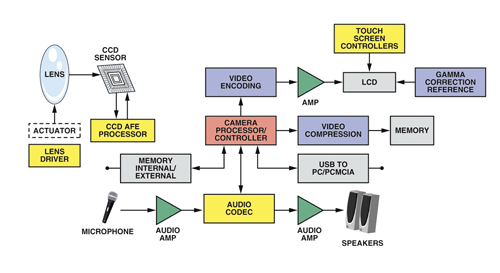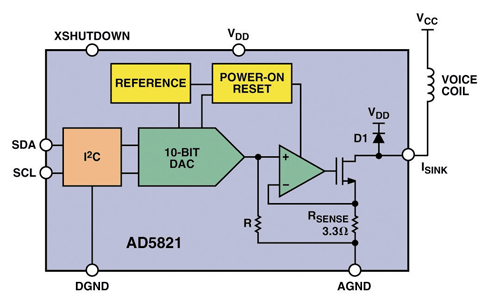Lens drivers propel high-res cell phone cameras
New lens drivers and other components will propel the continued evolution of handset camera modules.
BY MARK MURPHY, MEL CONWAY, and GARY CASEY
Analog Devices, Norwood, MA
http:\www.analog.com
The resolution and performance of cell-phone cameras is improving quickly. State-of-the-art resolution was 0.3 MP (megapixels) in 2000; the first AF (autofocus) handset camera (1.3-MP) was introduced in 2003; a 2-MP AF camera was launched in 2005; and a 10-MP camera phone was announced in 2006.
This “Evolution of Resolution” is driving camera module development. In order to make best use of the increased resolution, effective and rapid AF must accompany the increase in pixels. With AF becoming a standard feature, ever-increasing resolution will call for additional camera features, such as optical zoom, shutter control, and image stabilization.

Fig. 1. In ae digital camera signal chain, the lens driver provides the power to move the lens in response to digital control signals.
A key element of these features is the ability to move the lens rapidly so as to achieve optimum focus. The lens driver provides the power to move the lens in response to digital control signals. Figure 1 shows a block diagram of a digital camera. The image projected by the lens onto a CMOS or CCD sensor is scanned, and in the case of a CCD is applied to an analog front-end processor, which amplifies and conditions the raw video signal, and converts it to digital.
For example, the AD9948 is a complete 10-bit analog signal processor for CCD imaging applications, designed to sample and condition the outputs of color-CCD arrays that might be found in low-end digital cameras. Once the image is in digital form, it can be edited, downloaded, or stored, and further processed for camera operations, such as gamma-correction, light sensitivity adjustment for flash, and lens drive for focusing. Beyond these basic elements, additional sensors can measure lens position, light, temperature, acceleration, and angular motion (for image stabilization). Motors/actuators can control the shutter, neutral density filter, iris, and lens cover.
Handset cameras vs.digital still cameras
Camera phones are today’s fastest-growing consumer market. Size and cost are of primary importance, but users are demanding real camera performance. High-resolution digital still cameras are readily available at low cost, but their technology is not immediately transferable to handsets because their requirements are rather different. DSCs are cameras, first and foremost—while the primary function of the handset is to make a call. The included camera module is a useful feature, but it can’t add substantially to cost—or make the phone bulkier. In addition, severe power-consumption restrictions mean that a camera module that eats significantly into talk time will never be a success.
Lens driver
A lens driver controls the actuator that moves the lens assembly back and forth to adjust focus in camera phones with greater than 2-MP resolution. Cameras with lower resolution don’t require AF, so they don’t require a lens driver. In addition to focusing, some higher-resolution cameras may use lens drivers to position the lens for image stabilization. Figure 2 shows a lens driver and some of its inputs and outputs.

Fig. 2. The lens driver has many possible inputs and outputs.
DSCs traditionally use digital stepper motors as actuators; the stepper has proven to be robust, easy to drive, and it can be used to drive both AF and zoom lens actuators. Another advantage of the stepper is that after the required focus or magnification is achieved, no holding power is required to keep the lens in place. But steppers currently used in DSCs are large, expensive, complex, noisy, slow, and power-hungry.
These factors all tend to make steppers unsuitable for camera modules in phones. Furthermore, as features are added to camera phones, space constraints and the required level of integration creates a severe disadvantage for steppers.
An emerging actuator technology is based on piezoelectric materials. The piezoelectric actuator is mechanically simple, can make rapid movements, and is energy efficient. It can be used for both AF and zoom applications, and no hold power is required to maintain lens position after a lens movement is complete.
Unfortunately, the drive schemes for piezoelectric elements are complex and still in flux. Also, piezoelectric materials have a high temperature coefficient, demanding temperature compensation of frequency, phase difference, and duty-cycle.
The third option in actuator technology, the voice-coil motor with spring return, is the smallest, lowest-cost solution for AF on the market today; it is also the simplest to implement. These factors are important because camera modules with AF are currently the highest-volume products in this market.
Movements using VCMs are repeatable and gearless, with lens position fixed by balancing motor and spring forces. The spring returns the lens to the infinite-focus position, and no power is dissipated unless focusing is required. It is mechanically robust, shock-resistant, and has low-cost mechanics. These motors have negligible hysteresis and, therefore, have a direct current-versus-position relationship, so that lens-position feedback is not required.
The displacement, or stroke, of a spring-preloaded linear motor varies with the current through the coil. The start current, or threshold current that must be exceeded for any displacement of the spring-preloaded linear motor to occur, is usually 20 mA or greater.
The rated stroke or displacement is usually 250 to 400 µm, and the slope of the transfer curve is about 10 µm/mA. The maximum lens displacement for AF is of the order of 300 to 400 μm, so the VCM is a good fit for this level of functionality. Unlike the piezoelectric actuator and stepper motor, however, the VCM does consume power while holding the lens in focus.
Other motor/actuator technologies are available with more coming, however they remain immature, or proprietary, or have other issues.
| Available actuator technologies. | |||
| Motor Type | Voice Coil Motor (VCM) | Piezo motor | Stepper motor |
| Size | Small | Small | Largest |
| Cost | Lowest | Low | Highest |
| Speed (Auto Focus) | 10 ms | 3 ms | 100 ms |
| Energy (mJ) | 2.4 | 0.7 | 21 |
| Bi-directional | Yes-with spring | Yes | Yes |
| Index/rest position | Yes | No | No |
| Repeatability | Good | Poor | Medium |
| Gears Required | No | No | Yes |
| Acoustic noise | – | – | High |
| Power Transistors to Drive Motor | 1 | 4 | 8 |
| Applications | AF and On/Off functions | AF & Zoom | AF & Zoom |
Driving the VCM
The core of the complete VCM-driver is a 10-bit D/A converter with 120-mA output-current-sink capability, as shown in Fig. 3 . The D/A converter, loaded by resistor R, generates a voltage that drives the non-inverting input of the operational amplifier.

Fig. 3. The voice-coil motor, is the smallest, lowest-cost solution for AF on the market today.
Feedback causes this voltage to appear across RSENSE , which generates the sink current required to drive the voice coil. Resistors R and RSENSE are matched on-chip. Their temperature coefficient and nonlinearity over temperature are therefore matched, minimizing the output drift over temperature. Diode D1 provides output protection, and dissipates the energy stored in the voice coil when the device is powered down, or every time the voice coil current is switched to a lower value.
The handset camera module market is complex, with interdependency between companies making the image sensors, those who produce the mechanics for the optical module, the lens manufacturers, and the lens driver manufacturers. Digital still cameras are evidence of what can be achieved by dedicated design, but one of the primary challenges in reducing size, cost, and power is to further integrate additional functionality within the lens driver. ■
For more on lens drivers, visit http://electronicproducts-com-develop.go-vip.net/linear.asp.
Advertisement
Learn more about Analog Devices





